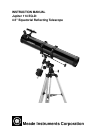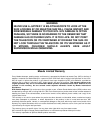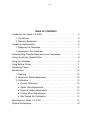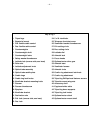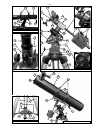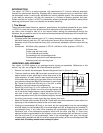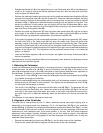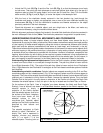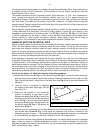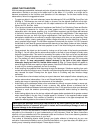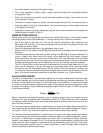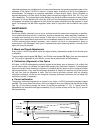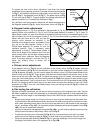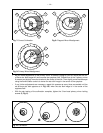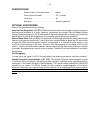
– 11 –
• Cloud belts across the surface of the planet Jupiter.
• The 4 major satellites of Jupiter, visible in rotation about the planet, with the satellite positions
changing each night.
• Saturn and its famous ring system, as well as several satellites of Saturn, much fainter than the
major satellites of Jupiter.
• The Moon: A veritable treasury of craters, mountain ranges and fault lines. The best contrast for
viewing the Moon is during its crescent phase. The contrast during the full Moon phase is low due
to the angle of illumination.
• Deep-Space: Nebulae, galaxies, multiple star systems, star clusters–hundreds of such objects are
visible through the Jupiter 114 EQ-D.
USING SETTING CIRCLES
Setting circles of the polar aligned equatorial mount can facilitate the location of faint celestial objects
not easily found by direct visual observation. To use the setting circles, follow this procedure:
• Use a star chart or star atlas, and look up the celestial coordinates, Right Ascension and
Declination (R.A. and Dec.), of an easy-to-find bright star that is within the general vicinity of the
faint object you wish to locate.
• Center the determined bright star in the telescope’s field of view.
• Manually turn the R.A. setting circle (27, Fig. 1) to read the R.A. of the object now in the telescope’s
eyepiece.
• The setting circles are now calibrated (the Dec. setting circle (28, Fig. 1) is factory calibrated). To
locate a nearby faint object using the setting circles determine the faint object’s celestial
coordinates from a star chart, and move the telescope in R.A. and Declination until the setting
circles read the R.A. and Dec. of the object you are attempting to locate. If the above procedure
has been carefully performed, the faint object will now be in the field of a low power eyepiece.
• The R.A. Setting Circle must be manually re-calibrated on the current Right Ascension of a star
every time the telescope is set up, and reset to the centered object’s R.A. coordinate before
moving to a new R.A. coordinate setting. The R.A. Setting Circle has two sets of numbers, the
inner set is for Southern hemisphere use while the outer set of numbers (the set closest to the R.A.
gear), is for use by observers located North of the Earth’s equator (e.g., in North America).
CALCULATING POWER
The power, or magnification of the telescope depends on two optical characteristics: the focal length
of the main telescope and the focal length of the eyepiece used during a particular observation. For
example, the focal length of the Jupiter 114 EQ-D telescope is fixed at 900mm. To calculate the power
in use with a particular eyepiece, divide the focal length of the eyepiece into the focal length of the main
telescope. For example, using the MA 25mm eyepiece supplied with the Jupiter 114 EQ-D, the power
is calculated as follows:
Power =
90mm
= 36x
25mm
Meade Instruments manufactures several types of eyepiece designs that are available for your
telescope. The type of eyepiece (“MA” Modified Achromatic, “SP” Super Plössl, etc.) has no bearing
on magnifying power but does affect such optical characteristics as field of view, flatness of field, eye
relief, and color correction.
The maximum practical magnification is determined by the nature of the object being observed and,
most importantly, by the prevailing atmospheric conditions. Under very steady atmospheric “seeing,”
the Jupiter 114 EQ-D may be used at powers up to about 228x on astronomical objects.
The maximum practical magnification is determined by the nature of the object being observed and,
most importantly, by the prevailing atmospheric conditions. Under very steady atmospheric “seeing,”
the Jupiter 114 EQ-D may be used at powers up to about 228x on astronomical objects. Generally,
however, lower powers of perhaps 75x to 175x will be the maximum permissible, consistent with high
image resolution. When unsteady air conditions prevail (as witnessed by rapid “twinkling” of the stars),
extremely high-power eyepieces result in “empty magnification,” where the object detail observed is
actually diminished by the excessive power.



